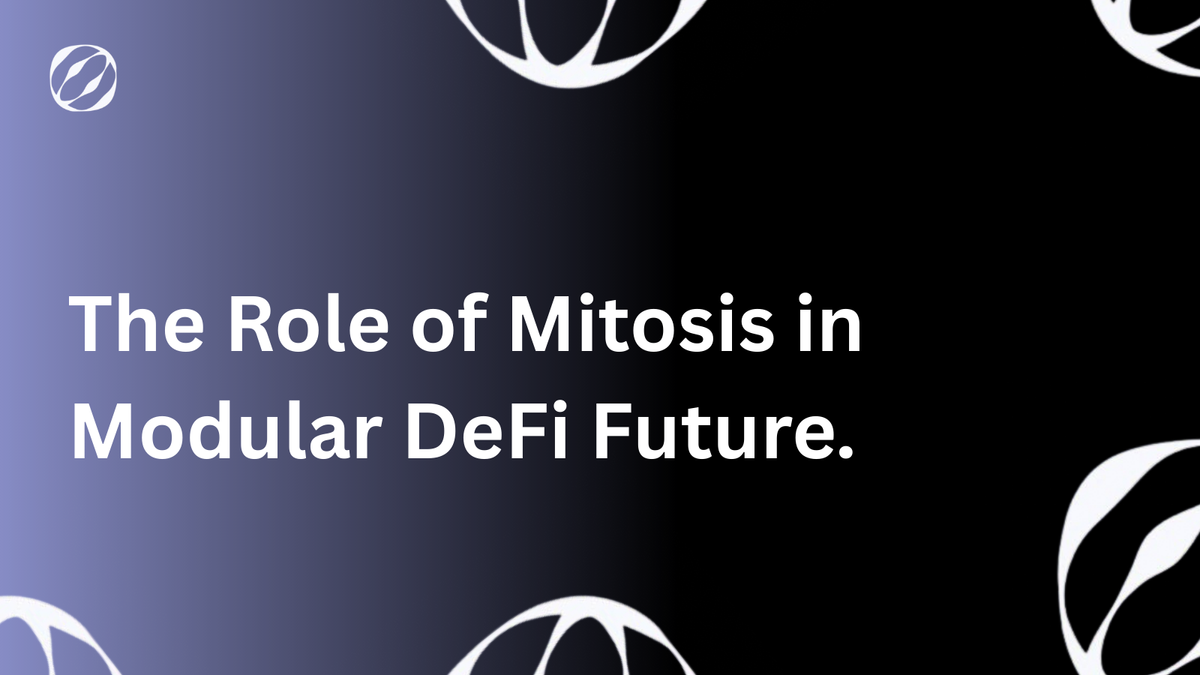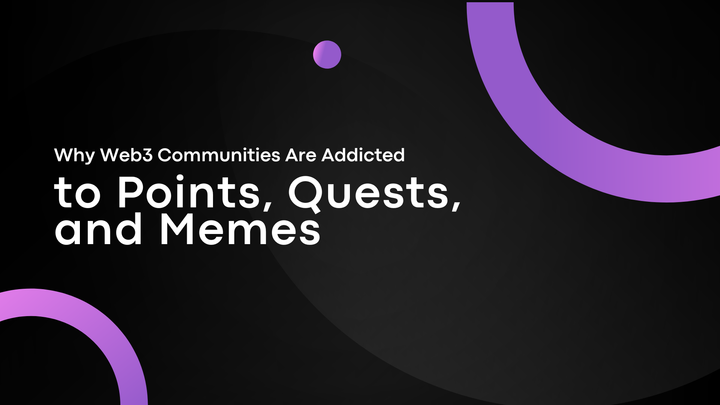The Role of Mitosis in Modular DeFi Future – Does it Align with Modular Blockchain Trends?

Introduction
DeFi has been scattered across isolated chains for a long time, forcing users to navigate complex bridges and liquidity.
DeFi users only wish for an effortless flow of liquidity across ecosystems, to unlock its true composability and efficiency.
We have Modular blockchains like mitosis building towards this.
The move toward modular blockchains is a significant transition happening in the crypto space. We have projects like Celestia, EigenLayer, and Rollups redefining how blockchains scale and interact.
But with these advancements comes a crucial challenge which is liquidity fragmentation.
If modular blockchains are to reach their full potential, liquidity must be just as flexible, dynamic, and interconnected as the networks themselves.
We'll explore:
- The rise of modular blockchains and why they matter.
- How Mitosis addresses liquidity fragmentation in this new paradigm.
- Why programmable liquidity and ecosystem-owned liquidity are key innovations.
- How Mitosis ensures security, flexibility, and cross-chain compatibility.
If you want to understand where DeFi is headed and how liquidity will adapt to a multi-chain future.
First, you need to know Mitosis.
Mitosis is a modular liquidity protocol built to solve liquidity fragmentation by offering programmable liquidity, ecosystem-owned liquidity (EOL), and cross-chain compatibility.
As modular blockchains decouple execution, consensus, and data availability, Mitosis ensures liquidity remains fluid and efficient across all layers.
What Are Modular Blockchains?
Traditional blockchains like Ethereum and Solana are monolithic, meaning they handle execution, consensus, and data availability on a single chain. While this approach ensures security and decentralization, it limits scalability and flexibility.
Modular blockchains break these functions into separate layers, allowing the need for customization, efficiency, and greater scalability. It is composed of interconnected modules or components, each responsible for specific functions.
Some key innovations driving this shift include:
- Celestia – A data availability layer that enables rollups to scale independently.
- EigenLayer – A restaking mechanism that enhances security across multiple networks.
- Rollups (Optimistic & ZK-Rollups) – Scaling solutions that move execution off the main chain while leveraging Ethereum’s security.
This modular design allows networks to specialize in specific functions, but it also creates liquidity fragmentation, a problem Mitosis is built to solve.
How Mitosis addresses liquidity fragmentation.
Liquidity fragmentation occurs when assets are spread across multiple chains, making it difficult to efficiently trade, stake, or lend assets across ecosystems.
Mitosis addresses this with three core solutions:
Mitosis aims to introduce programmable liquidity, where liquidity positions are tokenized into derivative assets. This allows liquidity providers (LPs) to:
- Move their liquidity seamlessly across different chains.
- Use their liquidity tokens in DeFi applications for yield generation.
- Reduce capital inefficiency by unlocking previously idle liquidity.
Unlike traditional liquidity provision, where LPs are often at the mercy of incentives that can quickly dry up, EOL ensures a more sustainable model.
With Mitosis:
- Liquidity is pooled under a decentralized governance structure.
- Liquidity providers have greater control over how assets are allocated.
- The model supports long-term stability rather than short-term incentives.
- Cross-Chain Compatibility
Mitosis enables liquidity to move seamlessly across multiple blockchains. Instead of relying on traditional bridges which are often a security risk, Mitosis acts as a decentralized value exchange layer, ensuring that assets remain interoperable and liquid in a multi-chain world.
Why Programmable Liquidity and Ecosystem-Owned Liquidity are important to DeFi.
Liquidity is the foundation of DeFi, but traditional models often suffer from inefficiencies like mercenary capital, unsustainable incentives, and capital inefficiency.
Two key innovations: programmable liquidity and ecosystem-owned liquidity (EOL), are changing the view on liquidity management for greater efficiency, sustainability, and resilience.
- Programmable Liquidity:
This leverages smart contracts to allocate, adjust, and optimize liquidity in response to market conditions.
It enables automated liquidity management, targeted incentives, and composability, making capital more efficient (e.g., Uniswap V3’s concentrated liquidity). This approach will reduce unnecessary token emissions and enhance risk mitigation through time-locked liquidity and adaptive fee structures.
- Ecosystem-Owned Liquidity (EOL):
This ensures protocols control their liquidity instead of relying on short-term LPs who farm and dump rewards.
By accumulating liquidity through bonding mechanisms (e.g., Olympus DAO’s POL model), protocols earn trading fees instead of paying LP incentives, making liquidity a sustainable revenue source rather than a cost. This model prevents liquidity drains, enhances market stability, and aligns liquidity with long-term protocol growth.
How Does Mitosis Ensure Security, Flexibility, and Cross-Chain Compatibility in DeFi?
Security, flexibility, and compatibility are searched by DeFi users and mitosis ensures this in the following ways.
- Security:
- Mitosis minimizes reliance on centralized intermediaries, ensuring liquidity flows are verifiable and resistant to exploits.
- Transactions undergo rigorous verification to prevent malicious activity, ensuring safe cross-chain liquidity transfers.
- Unlike traditional bridges, which are frequent targets of attacks, Mitosis enhances security through multi-party computation (MPC) and cryptographic techniques that reduce vulnerabilities.
- Flexibility:
- Composable Liquidity allows developers to tailor liquidity provisioning according to specific protocol needs. This means dynamic rebalancing, targeted incentives, and optimal capital allocation based on real-time demand.
- Mitosis enables assets to move efficiently between chains while maintaining deep liquidity pools.
- Built for modularity, Mitosis supports different DeFi applications, from AMMs to lending protocols, with customizable liquidity logic.
- Cross-Chain Compatibility:
- Instead of fragmented liquidity pools on separate chains, Mitosis consolidates liquidity across ecosystems, reducing inefficiencies and slippage.
- Supports EVM and non-EVM chains, ensuring compatibility with a wide range of networks.
- Uses cross-chain messaging protocols and smart contract automation to facilitate smooth interactions across ecosystems like Ethereum, Cosmos, and Polkadot.
Why Mitosis Aligns with Modular Blockchain Trends
Mitosis enhances scalability by enabling modular ecosystems to outsource tasks to specialized layers while ensuring liquidity scales efficiently across networks. Its flexible liquidity layer adapts to evolving rollups and execution environments, facilitating seamless asset movement without reliance on a single blockchain. Prioritizing security, Mitosis minimizes dependence on wrapped assets and insecure bridging mechanisms, reducing risks and aligning with the trust-minimized approach of modular blockchains.
Conclusion
Modular blockchains are the future of scalability and interoperability, but they come with the challenge of liquidity fragmentation. Mitosis emerges as a key infrastructure layer, enabling programmable, cross-chain, and ecosystem-owned liquidity.
As DeFi continues to evolve, the ability to move assets efficiently, securely, and flexibly across networks will be crucial. Mitosis is not just a liquidity protocol, it’s the beginning of the next generation of DeFi.
References



Comments ()